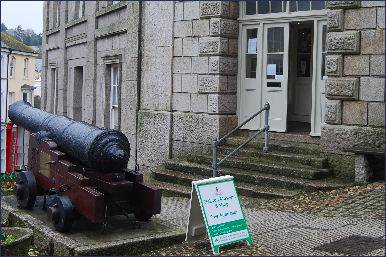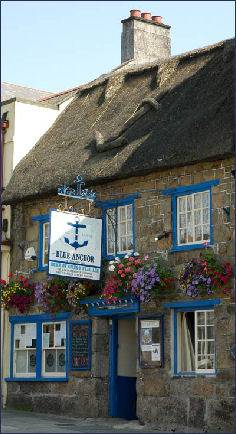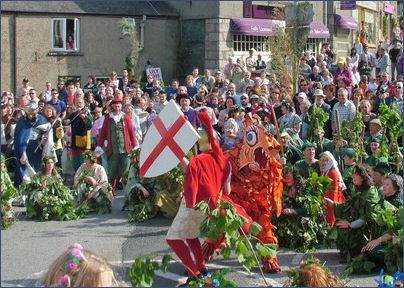Helston
OS Grid ref:- SW664273
 The historic market town of Helston, of ancient origins, is the most southerly town in Great Britain. It lies at the northern end of the stunningly beautiful Lizard Peninsula and is situated around 12 miles (19 km) to the east of Penzance.
The historic market town of Helston, of ancient origins, is the most southerly town in Great Britain. It lies at the northern end of the stunningly beautiful Lizard Peninsula and is situated around 12 miles (19 km) to the east of Penzance.
The town's name derives from the Cornish 'hen lis' or 'old court', 'ton' was added later to denote an Anglo-Saxon manor. The Domesday Book of 1089 mentions Henliston. It was granted its charter by King John in 1201.
Helston is well known for the kennels that run down the sides of its streets. About a foot wide and six to nine inches deep, there are a variety of theories as what their original purpose was - from washing tin ore to providing the town with a water supply. The Helston Town Trail covers the history of this ancient town, commencing at The Guildhall, the trail passes by all the local landmarks and reveals Helston's fascinating and varied history.
 The Blue Anchor pub, (pictured left) in in Coinagehall Street dates back to the fifteenth century and is one of the oldest original inns in Britain that continues to maintain a working brewery. It was originally a monks rest house, which produced a strong honey based mead.
The Blue Anchor pub, (pictured left) in in Coinagehall Street dates back to the fifteenth century and is one of the oldest original inns in Britain that continues to maintain a working brewery. It was originally a monks rest house, which produced a strong honey based mead.
Further along the same street, stands one of the oldest buildings in Helston, the Angel Hotel, which was once the town house of Lord Sidney Godolphin who was First Minister to three Monarchs and reputed to be one of the finest politicians in British history.
The Folk Museum (pictured right) boasts five display halls on three floors and has a a wealth of fascinating artefacts covering all aspects of life on the Lizard Peninsula through the ages. The museum is in the former butter market and dates to 1837. Outside stands a cannon, which taken from HMS Anson, wrecked at Loe Bar in 1807. At the end of Coinagehall Street stands The Monument, which was constructed in 1834 in Georgian gothic style in memory of Humphry Millet Grylls, a local banker and solicitor who helped to kep the local tin mine open.
 Helston once had a castle which occupied the site where the town's bowling green (near the Grylls Monument) is now located. The castle, was a simple Motte and Bailey structure, which was replaced in 1270 by a stone building of a similar design for Edmund, Earl of Cornwall, the younger brother of King Edward I. It had fallen into disuse and ruin by 1478.
Helston once had a castle which occupied the site where the town's bowling green (near the Grylls Monument) is now located. The castle, was a simple Motte and Bailey structure, which was replaced in 1270 by a stone building of a similar design for Edmund, Earl of Cornwall, the younger brother of King Edward I. It had fallen into disuse and ruin by 1478.
The Furry Dance
Helston is perhaps most famous for the 'Furry' or Floral Dance (pictured left) which dates back to pre-Christian times and is one of the oldest British customs still practised today. The word probably derives from Cornish: fer, "fair, feast" and is a celebration of the passing of Winter and the arrival of Spring.The Furry Dance is held in Helston on the 8th May, unless this date occurs on a Sunday or Monday when it takes place on the preceding Saturday. The streets are thronged with thousands of visitors and there is a carnival atmosphere. At 7.00am and 8.30am Hal-an-Tow, a kind of mystery play with various historical and mythical themes, is celebrated, in which St George and St Michael slay the Dragon and the Devil, cheered on by a crowd in Elizabethan dress.
The meaning of Hal-an-tow is lost in the mists of time which surround the festival The term "halan" means "calends" in Cornish, and"tow" is thought to mean "garland".